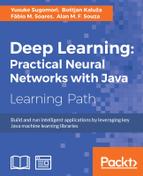 Summary
by Alan M. F. Souza, Fábio M. Soares, Boštjan Kaluža, Yusuke Sugomori
Deep Learning: Practical Neural Networks with Java
Summary
by Alan M. F. Souza, Fábio M. Soares, Boštjan Kaluža, Yusuke Sugomori
Deep Learning: Practical Neural Networks with Java
- Deep Learning: Practical Neural Networks with Java
- Table of Contents
- Deep Learning: Practical Neural Networks with Java
- Deep Learning: Practical Neural Networks with Java
- Credits
- Preface
- 1. Java Deep Learning Essentials
- 1. Deep Learning Overview
- 2. Algorithms for Machine Learning – Preparing for Deep Learning
- 3. Deep Belief Nets and Stacked Denoising Autoencoders
- 4. Dropout and Convolutional Neural Networks
- 5. Exploring Java Deep Learning Libraries – DL4J, ND4J, and More
- 6. Approaches to Practical Applications – Recurrent Neural Networks and More
- 7. Other Important Deep Learning Libraries
- 8. What's Next?
- 2. Machine Learning in Java
- 1. Applied Machine Learning Quick Start
- 2. Java Libraries and Platforms for Machine Learning
- 3. Basic Algorithms – Classification, Regression, and Clustering
- 4. Customer Relationship Prediction with Ensembles
- 5. Affinity Analysis
- 6. Recommendation Engine with Apache Mahout
- 7. Fraud and Anomaly Detection
- 8. Image Recognition with Deeplearning4j
- 9. Activity Recognition with Mobile Phone Sensors
- 10. Text Mining with Mallet – Topic Modeling and Spam Detection
- 11. What is Next?
- A. References
- 3. Neural Network Programming with Java, Second Edition
- 1. Getting Started with Neural Networks
- Discovering neural networks
- Why artificial neural networks?
- How neural networks are arranged
- The very basic element – artificial neuron
- Giving life to neurons – activation function
- The flexible values – weights
- An extra parameter – bias
- The parts forming the whole – layers
- Learning about neural network architectures
- Monolayer networks
- Multilayer networks
- Feedforward networks
- Feedback networks
- From ignorance to knowledge – learning process
- Let the coding begin! Neural networks in practice
- The neuron class
- The NeuralLayer class
- The ActivationFunction interface
- The neural network class
- Time to play!
- Summary
- 2. Getting Neural Networks to Learn
- 3. Perceptrons and Supervised Learning
- 4. Self-Organizing Maps
- Neural networks unsupervised learning
- Unsupervised learning algorithms
- Kohonen self-organizing maps
- Extending the neural network code to Kohonen
- Zero-dimensional SOM
- One-dimensional SOM
- Two-dimensional SOM
- 2D competitive layer
- SOM learning algorithm
- Effect of neighboring neurons – the neighborhood function
- The learning rate
- A new class for competitive learning
- Visualizing the SOMs
- Plotting 2D training datasets and neuron weights
- Testing Kohonen learning
- Summary
- 5. Forecasting Weather
- Neural networks for regression problems
- Loading/selecting data
- Choosing input and output variables
- Preprocessing
- Normalization
- Adapting NeuralDataSet to handle normalization
- Adapting the learning algorithm to normalization
- Java implementation of weather forecasting
- Collecting weather data
- Delaying variables
- Loading the data and beginning to play!
- Let's perform a correlation analysis
- Creating neural networks
- Training and test
- Viewing the neural network output
- Empirical design of neural networks
- Summary
- 6. Classifying Disease Diagnosis
- 7. Clustering Customer Profiles
- 8. Text Recognition
- 9. Optimizing and Adapting Neural Networks
- 10. Current Trends in Neural Networks
- A. References
- Chapter 1: Getting Started with Neural Networks
- Chapter 2: Getting Neural Networks to Learn
- Chapter 3: Perceptrons and Supervised Learning
- Chapter 4: Self-Organizing Maps
- Chapter 5: Forecasting Weather
- Chapter 6: Classifying Disease Diagnosis
- Chapter 7: Clustering Customer Profiles
- Chapter 8: Text Recognition
- Chapter 9: Optimizing and Adapting Neural Networks
- Chapter 10: Current Trends in Neural Networks
- Bibliography
- 1. Getting Started with Neural Networks
- Index
In this chapter, you learned about two deep learning algorithms that don't require pre-training: deep neural networks with dropout and CNN. The key to high precision rates is how we make the network sparse, and dropout is one technique to achieve this. Another technique is the rectifier, the activation function that can solve the problem of saturation that occurred in the sigmoid function and the hyperbolic tangent. CNN is the most popular algorithm for image recognition and has two features: convolution and max-pooling. Both of these attribute the model to acquire translation invariance. If you are interested in how dropout, rectifier, and other activation functions contribute to the performance of neural networks, the following could be good references: Deep Sparse Rectifier Neural Networks (Glorot, et. al. 2011, http://www.jmlr.org/proceedings/papers/v15/glorot11a/glorot11a.pdf), ImageNet Classification with Deep Convolutional Neural Networks (Krizhevsky et. al. 2012, https://papers.nips.cc/paper/4824-imagenet-classification-with-deep-convolutional-neural-networks.pdf), and Maxout Networks (Goodfellow et al. 2013, http://arxiv.org/pdf/1302.4389.pdf).
While you now know the popular and useful deep learning algorithms, there are still many of them that have not been mentioned in this book. This field of study is getting more and more active, and more and more new algorithms are appearing. But don't worry, as all the algorithms are based on the same root: neural networks. Now you know the way of thinking required to grasp or implement the model, you can fully understand whatever models you encounter.
We've implemented deep learning algorithms from scratch so you fully understand them. In the next chapter, you'll see how we can implement them with deep learning libraries to facilitate our research or applications.
-
No Comment